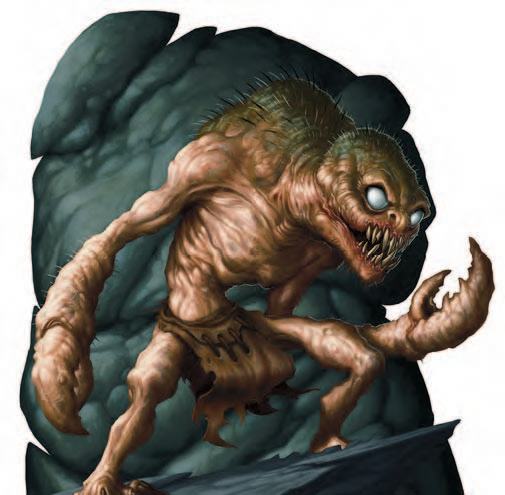The Caevrnbrood
A deep-dwelling base class
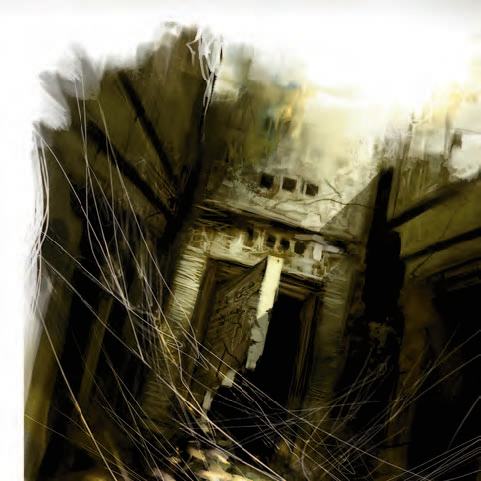
The Caevrnbrood
A goblin's eyes become pitch-dark pools as he slinks through shadows, his steel claws ready to rend. As the blood sprays from his target, he fades back into the self-same shadows.
A human with unnaturally pale skin stands still as stone, then suddenly surges into motion. His milk-white eyes give lie to his enhanced senses.
An orc, covered in strange fur-like scales, lashes out with a potent sting hidden in his fist. His victim falls, writhing with otherworldly venom.
Cave-bound Souls
The Feydark is both horrifying and mesmerizingly beautiful. For a rare few, it has an additional trait. For these people, the Feydark, and places like it, is comforting. Oppressive darkness becomes as a warm cloak. Claustrophobic crags and crevices are as spacious dens. The eerie glow of luminous fungi and gleaming crystal is as a cheery fire.
These individuals are cave-bound. Though most will never see the Feydark themselves, they are bound to its very threads and winding tunnels, destined to lives of crawling into holes and seeking dark places.
Awakening
Rarely, a cave-bound soul will awaken, transforming themselves body and mind into something more adapted for the deep places and the silent stones of the Feydark. One may take on aspects of the prowling beasts that live within; lashing out with unsettling weaponry grown from his own body, while another becomes liquid shadow, slinking and lurking. Still others may take on the aspects of the glowing fungus, or the unearthly crystals.
These awakened individuals are known as Caevrnbrood, and they can develop their powers further through focus and intent.
Creating a Caevrnbrood
When creating a Caevrnbrood ask yourself the following questions. What behaviors in their life before awakening hinted at their potential transformation? Perhaps they often dreamed of the Feydark, while never knowing what they saw, or they never used a lantern even in the most pitch of night.
When they awakened, was it spontaneous, drawn out, or effected by some powerful ritual, either their own or another's? Do they embrace their power willingly, or use it begrudgingly? How did their former friends and acquaintances receive their mystically altered nature?
Quick Build
You can make a Caevrnbrood quickly by following these suggestions. First, your highest ability score should be Wisdom, followed by Dexterity. Second, choose the Urchin background.
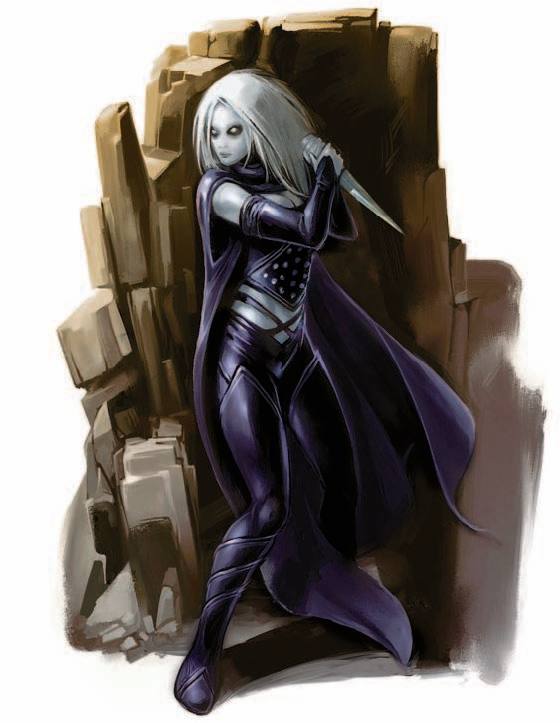
The Caevrnbrood
| Level | Proficiency Bonus |
Features | Lurk Uses |
|---|---|---|---|
| 1st | +2 | Deep Aspect, Cavesight | -- |
| 2nd | +2 | Lurk, Unsettling Guise | 2 |
| 3rd | +2 | Minor Adaptation | 2 |
| 4th | +2 | Ability Score Improvement | 3 |
| 5th | +3 | Extra Attack | 3 |
| 6th | +3 | Minor Adaptation | 3 |
| 7th | +3 | Deep Aspect Feature | 3 |
| 8th | +3 | Ability Score Improvement | 4 |
| 9th | +4 | Lurk Improvement | 4 |
| 10th | +4 | Ability Score Improvement | 4 |
| 11th | +4 | Deep Aspect Feature | 5 |
| 12th | +4 | Ability Score Improvement | 5 |
| 13th | +5 | Major Adaptation | 5 |
| 14th | +5 | Shadowed Vitality | 6 |
| 15th | +5 | Cavesight Improvement | 6 |
| 16th | +5 | Ability Score Improvement | 6 |
| 17th | +6 | Shadowflight | 7 |
| 18th | +6 | Major Adaptation | 7 |
| 19th | +6 | Ability Score Improvement | 7 |
| 20th | +6 | Deep Aspect Feature | Unlimited |
Class Features
As a Caevrnbrood, you gain the following features:
Hit Points
- Hit Dice: 1d8 per Caevrnbrood level
- Hit Points at 1st Level: 8 + your Constitution modifier
- Hit Points at Higher Levels: 1d8 (or 5) + your Constitution modifier per Caevrnbrood level after 1st.
Proficiencies
- Armor: Light armor
- Weapons: Simple weapons, martial weapons
- Tools: None
- Saving Throws: Wisdom, Strength
- Skills: Choose 2 from Acrobatics, Arcana, Athletics, Deception, Intimidate, Sleight of Hand, Stealth, and Survival
Equipment
You start with the following equipment, in addition to the equipment granted by your background:
- (a) any simple or martial weapon
- (a) a light crossbow with 20 bolts or (b) any simple weapon
- (a) leather armor
- (a) a dungeoneer's pack
Deep Aspect
Every caevrnbrood that awakes becomes a reflection of some property or feature of the Feydark, and by extension of all places of primal darkness. Choose one of the options detailed at the end of this class description. Your choice grants you features when you pick it and again at levels 7, 11, and 20.
Cavesight
You were already accustomed to darkness before awakening, but since awakening your eyes see clearly even in complete darkness. You gain darkvision with a range of 120 feet. Unlike normal darkvision, you can perceive color even in complete darkness.
At 15th level, this feature improves. You can now perceive invisible creatures and objects within the range of your darkvision and treat darkness as bright light for the purposes of vision within that range. In addition, you can see through even magical darkness.
Lurk
At 2nd level, you learn to wrap yourself in the eerie still of the cave, taking on unnatural stealth. As a bonus action on your turn, you may heavily conceal yourself with darkness manifested from the Feydark until the end of your turn. Creatures that cannot see through darkness additionally treat you as though you were invisible while concealed in this way. While lurking, your melee attacks deal additional psychic damage equal to the original damage dice plus your Wisdom Modifier. After lurking, you may add your Wisdom bonus to your armor class until the start of your next turn.
You may use your Lurk a number of times as indicated on your class table. You regain all uses of Lurk whenever you complete a short or a long rest.
At 9th level, the concealment from Lurk lasts for up to a minute, ending early at the end of any turn in which you attack or cast a spell, or when you choose to end it on your turn (no action required). In addition, creatures now treat you as invisible while concealed with Lurk unless they are capable of seeing through magical darkness.
Unsettling Guise
Also at 2nd level, your transformation begins to take root in your appearance. You gain unusual characteristics tied to your Deep Aspect, which are readily apparent to viewers. For example, a Nightflower might grow creepers and tendrils in place of hair, while a Voidfang might have their eyes, nostrils, and mouth replaced by pitch-dark voids. Your guise grants you a bonus on Intimidate checks equal to your Wisdom bonus while it is not suppressed.
As an action on your turn, you can suppress your guise and resume your original appearance until the next time you Lurk or until you choose to resume it (no action required).
Minor Adaptation
At 3rd level, your body's changes grant you an increased ability to thrive in severe environments. Choose one of the following options:
- Chill. You are resistant to cold damage. You ignore environmental penalties for extreme cold.
- Gasp. You can hold your breath for up to an hour. When you damage a creature while lurking, that creature can only speak in a whisper audible no more than 10 feet away until the end of your next turn.
- Famine. You have advantage on saving throws against poison and disease. You can survive a number of days equal to your Constitution Score without the need to consume food. After going without food for any number of days, you must consume double the normal amount of food for as many days in order to regain those days for this feature.
- Parch. You only need one gallon of water every ten days plus your Constitution Modifier in order to survive. When under water, you can choose to sink harmlessly to the bottom at a rate of 60 feet per round and move around unimpeded as if you were walking. You do not suffer disadvantage on attack rolls while moving on the bottom of a body of water in this fashion, but must still hold your breath or have a way to breathe underwater.
- Vertigo. You have advantage on Dexterity (Acrobatics) checks made to balance on narrow ledges. If you would fall from a height of ten feet or more and are within five feet of a ledge or other handhold, you may use your Reaction to make a DC 20 Dexterity (Acrobatics) check. If you succeed, you grab the ledge or other handhold instead.
You may change your minor adaptation any time you gain a level in this class. At 6th level, you choose an additional minor adaptation. You may change either one of them when changing your adaptation upon gaining a level in this class, but not both in the same level.
Ability Score Improvement
When you reach 4th level, and again at 8th, 12th, 16th, and 19th level, you can increase one ability score of your choice by 2, or you can increase two ability scores of your choice by 1. As normal, you can’t increase an ability score above 20 using this feature. Alternatively, you can choose a feat (see Chapter 6 of the Player's Handbook for a list of feats).
Extra Attack
Beginning at 5th level, you can make two attacks, instead of one, whenever you take the Attack action on your turn.
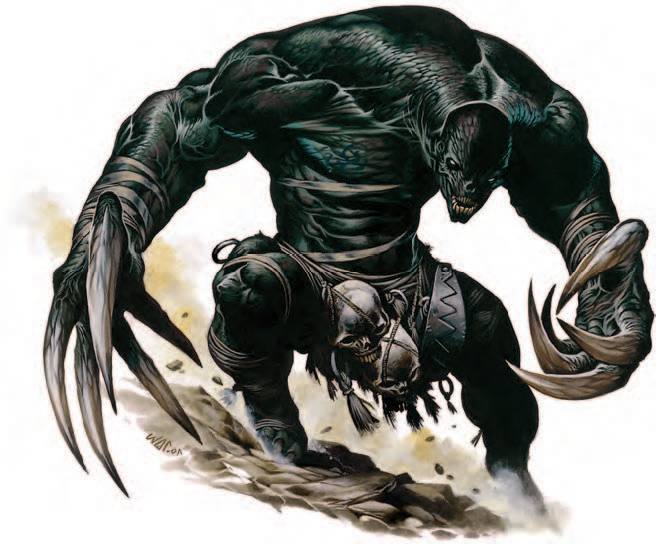
Major Adaptation
At 13th level, your body's changes become more severe, granting you great power at a cost. You may choose one of the following options:
-
Amorphous. Your bones and organs become semi-gelatinous, allowing you to squeeze through openings impossibly small for a creature your size.
- Benefit. You can fit through openings as small as 6" in diameter without becoming trapped.
- Drawback. Your carrying capacity is half what it normally would be for a creature your size.
-
Chromatophores. Your skin shifts through dappling colors at a whim, causing you to blend into your background like a cuttlefish or squid.
- Benefit. You may add twice your proficiency bonus to Dexterity (Stealth) checks, and you can change the color of your skin at will by concentrating (as if concentrating on a spell). While you are not concentrating, your skin shifts randomly through colors in response to your surroundings and emotions.
- Penalty. You can no longer suppress your Unsettling Guise (though you can still mask it through other means). While your skin is visible, you must make also Constitution save whenever you make a Charisma (Deception) check. Use the lower of the two values as the result of the check. If this check fails, you lose concentration on your skin color.
-
Flinthide. Your skin becomes covered in stone-like protrusions, similar in appearance to scales, fur, or spines. While your Unsettling Guise is suppressed, these growths appear to be scars, lesions, or pock-marks. This feature does not function when calculating your armor class using Unarmored Defense or any similar feature.
- Benefit. Your armor class increases by 2. When a creature within 5 feet of you damages you with a melee attack, you can use your reaction to deal 1d6 piercing damage plus your Wisdom modifier to that creature.
- Drawback You can no longer wear armor of any kind (you can still use a shield).
-
Raptorial. One of your arms grows into a massive mantis-like claw. While your Unsettling Guise is suppressed, your claw arm appears to be a simple prosthetic such as a hook.
- Benefit. You gain a claw attack with a 15-foot reach that deals 1d10 piercing damage and has the Finesse property. You can also attempt to grapple using your claw or make unarmed attacks with it. You only gain this benefit while your Unsettling Guise is not suppressed.
- Drawback. Your claw is unsuitable for tasks that require fine motor control, and cannot grasp weapons or use a shield.
When you gain a level in this class, you may exchange your Major Adaptation for another option from the list.
At 18th level, you may select a second major adaptation, or you may choose to negate the penalty associated with your existing major adaptation.
Shadowed Vitality
Beginning at 14th level, you have resistance to slashing, bludgeoning, and piercing damage the first time you are attacked while you are standing in darkness. Once you reduce damage using this ability, its effects are lost until the next time you Lurk or complete a short or long rest.
The armor class bonus from Lurk counts as standing in darkness for the purposes of this feature.
Shadowflight
Beginning at 17th level, when you use your lurk ability on your turn, you may teleport to a space up to 30 feet away that you can see. If both you and your destination are in darkness, the range of this ability increases to 120 feet.
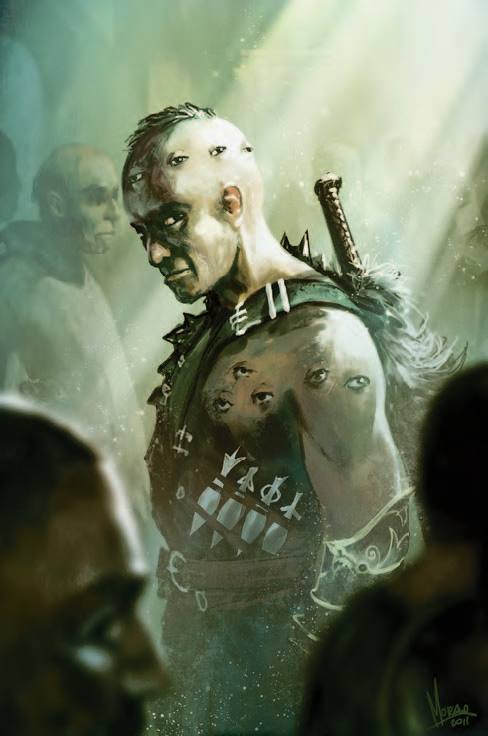
Deep Aspect
The caevrnbrood are mutated by their powers, as something supernatural takes root in their soul and begins to break out in times of stress or need. Though each caevrnbrood's transformation is distinct and unique, they always reflect some aspect of the Feydark.
Nightflower
Nightflower caevrnbrood are bonded strongly to the recyclers of the deep places beneath the ground. Fungi are the most common form to reflect for caevrnbrood of this aspect, but it also includes monstrous leeches and maggots, and even stranger creatures like the carrior crawler.
Toxic Touch
Your grasp spreads rot and decay, turning your bare skin into a deadly weapon. When you make an unarmed attack, you can choose to have that attack deal 1d8 necrotic or poison damage (your choice each time) instead of its normal damage. Add your Wisdom modifier, instead of your Strength modifier, to unarmed attacks made in this fashion.
Carrion Feast
When you become a nightflower, your appetites change. You can gain sustenance from spoiled food and never suffer the poisoned condition from consuming unhealthy food or from smelling garbage or other putrid smells.
As an action, you can cause up to a pound of food you touch to rot and spoil. Once you use this feature you cannot use it again until you have completed a short or a long rest.
Life Leech
At 7th level, you can bolster your own health with the decay of others. When you reduce a creature to 0 hit points, gain temporary hit points equal to half your level in this class. If you reduced the creature to 0 hit points with necrotic or poison damage, you instead gain temporary hit points equal to your levels in this class plus your Wisdom modifier.
Strength Sap
At 11th level, you can siphon the power from others when you attack them. When you deal psychic damage with your lurk ability, the target must make a Constitution saving throw with a DC equal to 8 + your Proficiency Bonus + your Wisdom modifier. On a failure, they deal half damage with all attacks and spells until the end of your next turn, and you retain the bonus damage and bonus to armor class from your lurk until the end of your next turn.
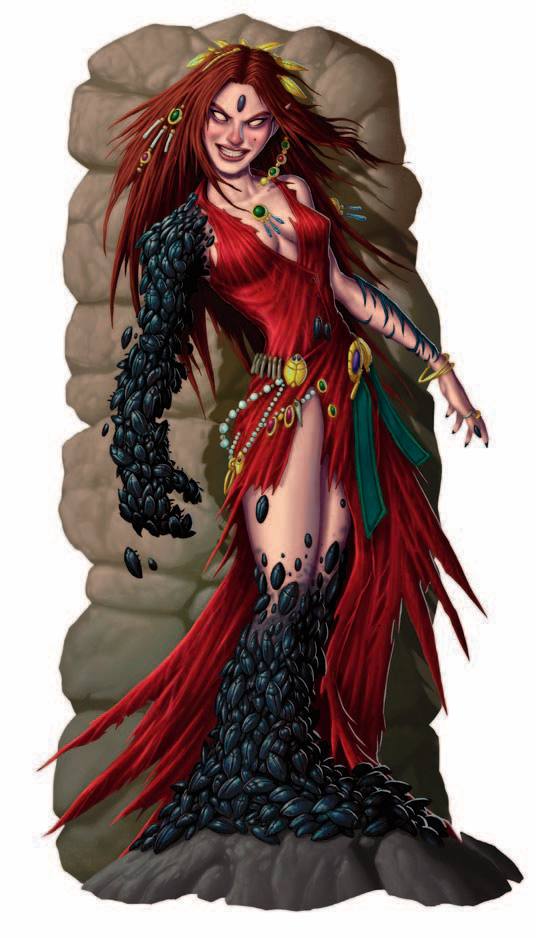
Shambler Cordyceps
At 20th level, you are capable of sustaining your own body through fungal infestation. If you are reduced to 0 hit points, you may choose to restore yourself to your maximum hit points instead. If you do, your type becomes plant instead of your original type, and you gain a weakness to radiant and fire damage and immunity to necrotic and poison damage, as well as the poisoned condition. These effects revert the next time you complete a long rest or if resurrection magic is used on you. You cannot use this feature if you are already under the effects of this feature.
Stonecloak
Stonecloak caevrnbrood embrace the crushing isolation and claustrophobia of the tunnel environment. They are reflections of cramped spaces and those small beings that scurry alone through and between the walls of the world.
Claustrophile
When you first develop this aspect, you have advantage on ability checks and saving throws to escape effects that cause you to be grappled or restrained. In addition, attacks against you do not have advantage while you are restrained. You still suffer all the other penalties of the restrained condition.
Crush Grip
When you develop this aspect at 1st level, your grasp reflects the immeasurable weight of stone. When you attempt to grapple a creature, you may resolve your Strength (Athletics) check against their armor class instead of using an opposed check. If you succeed, you deal 1d8 bludgeoning damage plus your Strength modifier, in addition to the other effects of a successful grapple.
If you are already grappling a creature, you must still succeed on a new grapple attempt to deal damage to them with this feature, but they do not escape the grapple if your attempt fails.
Crush Claw
Beginning at 7th level, your ability to grapple targets improves. You can attempt to grapple on all attacks when you take the Attack action, rather than just one. When you deal damage with your crush grip feature while using Lurk, you also deal bonus psychic damage as if your crush grip feature were a melee weapon.
Stonefriend
At 11th level, your comfort with deep places becomes such that you can fuse your body into stone objects and move through them with ease. You can store up to twice your Wisdom score pounds of primarily-stone objects in your body without them counting towards your carrying capacity. In addition, you ignore difficult terrain if the terrain is composed solely of rock, such as stalagmites or the spike growth spell.
Meld With Stone
At 11th level, you can climb into solid stone to gain shelter or cover. Once as an action, you can cast the spell meld with stone without expending a spell slot or requiring any components. You regain the ability to do so each time you complete a short or a long rest.
Rock Tomb
At 20th level, while you are grappling a creature, that creature is also restrained. The damage of your crush grip feature increases to 2d8.
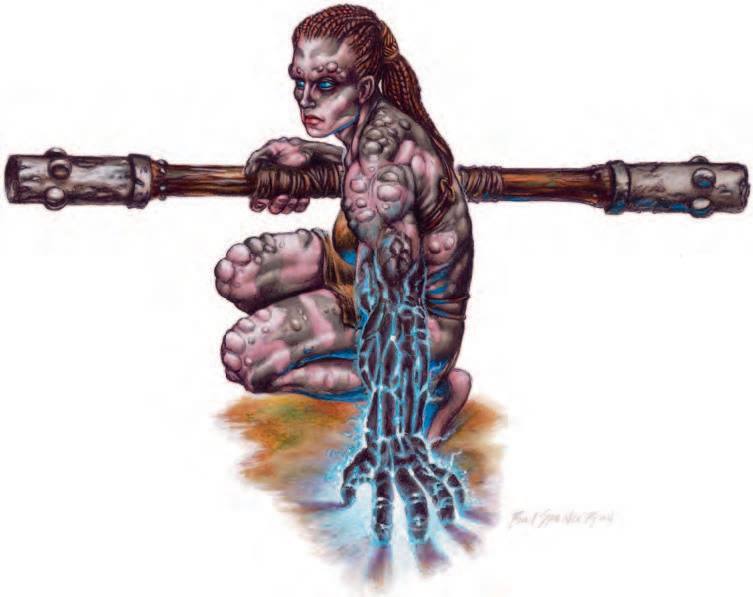
Voidfang
Voidfang caevrnbrood are representatives of the threats that hide just unseen. Unlike the other aspects, the voidfang can reflect traits from creatures throughout the worlds, both cavernous and surface. Those few scholars that study the feybound theorize that those creatures are themselves reflections of some abstraction woven into the Feydark.
Patient Stealth
When you first develop this aspect, you learn to stand so perfectly still that you seem to be scenery or furniture, rather than a living creature. You may attempt to make a Dexterity (Stealth) check while unobserverd for at least one minute, even if you are not obscured, so long as you remain completely motionless. You have disadvantage on this check unless you are standing in darkness.
First Impression
At 7th level, you can strike with such stunning speed that enemies are often left unaware. When you roll initiative, you may also lurk if you have a use of that feature remaining. If you do, the effects of lurk last until the end of your first turn in the combat, instead of the usual duration.
Empty Skin
At 11th level, your ability to blend into your surroundings becomes unmatched to the point that you seem transparent. You no longer suffer disadvantage on your Dexterity (Stealth) check when using patient stealth in bright or dimly lit areas. In addition, you can move up to your speed on your turn without ending your patient stealth feature. You must still remain motionless and unobserved for one minute in order to use patient stealth initially, and you must still refrain from other motion when it is not your turn.
Relentless Pursuit
At 20th level, you are a tireless predator. When you use your Reaction to take an Opportunity Attack against a creature, you may use your lurk ability as part of the same Reaction before resolving your attack. After the attack, you may move up to your speed, but you must move as close to the creature you attacked as possible.
